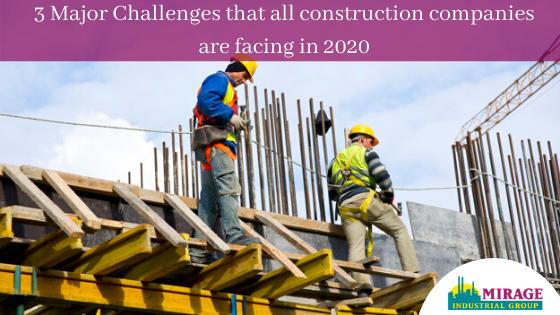11 Safety Measures To Be Considered On A Construction Site
Why is safety important on a construction site?
Over the past few years construction work has been increasing in both developed and underdeveloped countries. But along with this boom, accidents on the worksite have also increased. The construction site safety is the most overlooked aspect during a project due to the constant pressure that the industrial contractors and crews face to meet deadlines and stay within the budget.
As per the US Bureau of Labour Statistics (BLS) report, a total of 5250 workers died from work-related injuries in the US in 2018, up by 2% from the 2017 total of 5,147. These are alarming figures and the common reason cited for such accidents is unsafe to work practices at the construction site.
As per the US Bureau of Labour Statistics (BLS) report, a total of 5250 workers died from work-related injuries in the US in 2018, up by 2% from the 2017 total of 5,147. These are alarming figures and the common reason cited for such accidents is unsafe to work practices at the construction site.
Which are the top “Fatal Four” construction hazards?
Construction sites are filled with dangerous machinery, environments, hazards, and chemicals that can prove lethal without constant supervision. According to OSHA, the most common 4 hazards ("Fatal Four") that are responsible for construction accidents and workers deaths are:
- Fall due to unstable working ground or human error
- Being struck by a falling object
- Electrocution
- Being caught in something/between two objects
What are the important safety measures to be considered at a construction site?
If you're a construction project manager or a site manager, it should be your top priority to implement the right precautions and safeguard your workplace from unnecessary risks. At Mirage Industrial Group to overcome such fatalities we have put together a few best practices and strategies to improve the health and safety of workers at the construction site.
1. Proper training and communication:
An Industrial contractor should make sure that every worker is well aware of the dangers associated with construction jobs and train them to overcome these dangers. Workers should be properly trained regarding the handling of tools and equipment provided. It is advisable to hire a certified worker for operating heavy equipment. Companies should train the new laborers with the help of resources published by OSHA on standard safety and security practices. Also, worksheets, training videos, and onsite training opportunities should be provided.
Clear and effective communication at all times is the most important part of safety on the construction site. In case of doubts, the worker should feel free to ask the supervisor and execute the work in the correct way rather than handling things on their own. Workers should always be encouraged to speak up when they see something going wrong, this can help to avoid accidents. Workers should be equipped with devices like smartphones, walkie-talkies, or headsets which help in fast and efficient communication among team members.
2. Providing appropriate safety apparels and gears:
Construction services providers should supply Personal protective equipment (PPE) to all the workers on site. The workers should also compulsorily work wearing this safety equipment. A PPE includes the following.
- Hard hats or helmets should be worn at all times to avoid head injury due to falling objects, low-hanging hazards, and exposed wire tripping.
- Earplugs or muffs should be worn while working in a noisy area.
- Safety glasses or goggles and face shields should be used while doing welding, chipping, grinding, masonry work, sanding woodworking, and drilling.
- Fall harnesses are essential when workers are working high off to the ground.
- High gumboots or anti-slip footwear is necessary when working in a dusty or toxic environment.
- Hand gloves are also needed to prevent skin irritation and cuts while mixing cement, concrete, cutting metals, etc.
- Steel toe boots are made essential by OSHA to protect toes from getting severed or cut.
3. Appropriate use of equipment:
A safe construction site requires proper equipment and its appropriate usage. Construction workers using the wrong equipment are bound to get injured. The industrial construction company should make sure that all machinery and materials are well maintained.
- The operation of cranes and its surrounding should be inspected. Crane operators should be instructed not to swing loads over workers or the public.
- Ladders should be thoroughly checked. Even a slightly wobbled ladder should not be used. Ladders should be kept at least one meter above the ground level and it should be fastened at the upper and lower end.
- Scaffolds must be frequently inspected. Scaffolding must be 10 feet from power lines and workers have to maintain weight limits while transporting construction materials upward.
- Forklifts are effective but dangerous machinery therefore they should be operated only by trained and certified professionals. Forklifts should be properly maintained and no modifications should be made to them without prior approval. Also, forklifts should never be speeded or stopped suddenly in a slippery area. It is necessary to wear a seat belt while operating a forklift.
4. Ensure electrical safety at the construction site:
Electrocution is one of the leading causes of death on a construction site. The use of electrical transformers on a construction site development is dangerous due to the use of flexible extension cords and scattered power cables. Utmost care should be taken to ensure electrical safety at the construction site.
- All electrical lines should be grounded and electrical equipment should be insulated.
- Heavy equipment should be switched off when not in use.
- Extension cords should carry an adequate amount of current to avoid fluctuations and overloading.
- All construction electrical products should be UL approved and rated for heavy-duty usage.
- Drill machines and grinders should have protected cable and grounded metal casing.
Note: Never allow electrical tools to get wet. If a portable electric product is used in a damp area then the voltage should not exceed 230 volts.
5. Trenching safety:
Trenches are routes dug into the ground at different depths depending on the purpose. Construction workers working in trenches, often risk their life due to burials and suffocation. This is mainly due to the unstable nature of the soil which leads to the collapse of the trench.
Thus precautionary safety measures should be taken to prevent trenching injuries. Workers should not enter an unprotected trench. A 20-foot trench should be professionally designed with the protective system. Trench angles should not be steep and the exit way should be properly indicated. Never work in a trench with standing water or if the water is accumulating.
6. Ensure proper storage of material:
Construction services providers should ensure that the materials on the job site are properly stored when they are not in use, to prevent them from falling which may further lead to damage and injuries. Materials should not be stored in the passage area. It should be stored at least 6 feet away from the entrance and 10 feet from the edge of the floor. The weight of the material stored should not exceed the storage capacity. Chemicals should be stored in explosive storage cabinets using high quality and compliant storage solutions. This will reduce the risk of spillage, fire explosions, and serious injuries. Open flames should be kept away from areas where combustible materials are stored.
7. Readily availability of first aid kit:
A first aid kit is most essential on a construction site and it should be kept within the reach of the workers. Workers with minor cuts, burns, or a minor fall can be treated immediately using the first aid kit and can resume work right away. A quick treatment of minor injuries can prevent infection. Also, it’s a best practice to provide one first aid officer per 25 workers on a construction site.
8. Implement strict security on-site and safety protocols:
Access to the construction site should be restricted to protect heavy equipment and machinery from damage and thefts. The construction site should be declared as a restricted zone to safeguard pedestrians from the potential hazards of construction. Only authorized personnel should be allowed on site and safety protocols should be followed. Strict security and safety protocols will also safeguard contractors from liability, security breach, and litigation due to negligence of safety.
9. Clear display of signage:
An easy way employers can communicate with workers in different areas on the job site is through safety signs and labels. Yellow stickers with site SWMS (safety work method statement) should be posted on the construction site and should be clearly visible to workers. The signage should also include a 24-hour emergency number, map or direction leading to the construction office, location of fire extinguishers, first aid kit, emergency exits, and amenities (such as toilets) available on site.
Also, there should be proper lighting if it is required to work at night time.
10. Have a safe work method statement (SWMS):
An SWMS should be prepared and implemented before the commencement of the project. A safe work method statement is a legal document that outlines the high-risk construction work activities carried out within a workplace, the hazards that may arise from these activities and safety measures to be implemented to control the risk. Legally a construction work cannot commence until SWMS standards are met.11. Remain mindful of weather-related hazards:
Construction workers are at a high risk of weather dangers as they stay outside for their whole shift. Seasonal and unfavorable weather considerations should be accounted for and proper safety measures should be taken.For people working in hot temperatures, plenty of water, as well as a shady place, should be available on-site to protect them from dehydration and exposure-related illness. Regular breaks should be given to workers to overcome fatigue and tiredness. Also, cold packs should be worn around the neck to beat the heat. During winters it is recommended that workers wear layers and shift work hours during the warmest part of the day.
Conclusion:
Construction sites are one of the few places where risks can’t be removed but they can be minimized with the best safety measures. The CPWR report states that construction site injuries account for 6-9% of project costs, while safety and health programs account for a mere 2.5% of the project cost. So it is more advisable for a construction company to spend on safety and precautionary measures on the worksite rather than compensating the workers. Also, any news of a worker getting injured due to lack of safety measures will affect the goodwill of your construction firm.Are you looking at hiring an Industrial construction company? Then don’t look any further, contact Mirage Industrial Group today to discuss your construction site development requirement. We are a reliable team of Industrial contractors who not only offer construction services to our esteemed clients but stand firm for creating an injury-free and healthy life for our coworkers, clients, and construction partners



Thank you for the post! I just finished reading it up and am very excited to construction the following series. Just wanted to let you know that your posts/thoughts/articles give me invaluable insights! I cannot really be thankful enough for all that you do! Currently finishing up your Narratives & Numbers as well. What a Gem as well.
ReplyDeleteI just want to thank you for sharing your information and your site or blog this is simple but nice Information. I’ve ever seen like pozycjonowanie stron learn something today.
ReplyDelete